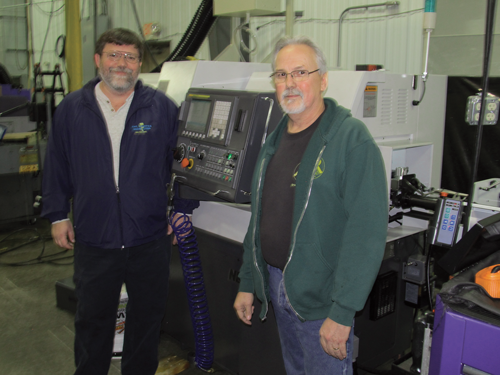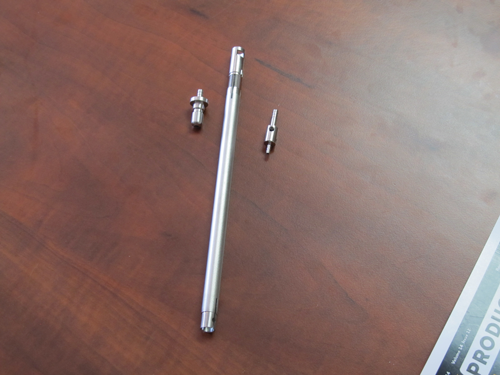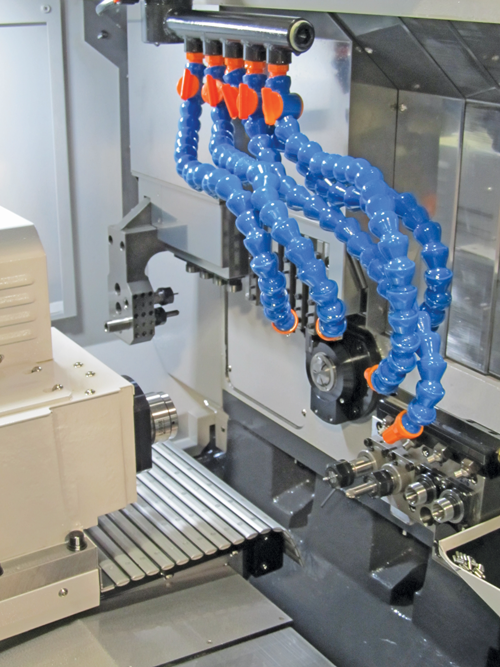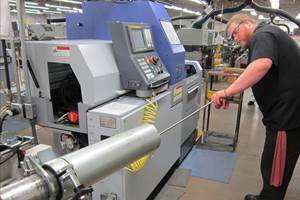Consolidating Operations with Swiss-Type Machines
This Ohio shop is learning about Swiss-type machines and finding how to blend the production advantages they bring into a smooth workflow. Machining parts complete in a single handling is one big advantage and a throughput goal for this shop.
Like many shops across the country, R&R Tool started in a one car garage. In 1985, Dan Reed set up shop in his 144-square-foot garage located in Blanchester, Ohio, and incorporated his business in 1990. Today, the company employs 65 in a 30,000-square-foot facility. He cut his metalworking teeth as a tool and die maker for fastener equipment maker Senco starting in 1979.
Mr. Reed’s company operates as a contract manufacturer and primarily serves the medical parts industry. It produces various discrete parts, mostly in stainless steel.
Most of the work received at R&R is divided between the milling department and the turning department, prismatic and parts of rotation. When the company first got into Swiss-type machining, some of those department lines began to blur as the capabilities of Swiss machining began to be explored.
Some of the work that traditionally would be assigned to a machining center then followed by a turning operation, could be processed complete on the Swiss-type machine. This saved the shop in-the-cut time and improved quality by eliminating re-fixturing position errors.
Learning Swiss
As the company (primarily Bill Elam, director of manufacturing) looks at a new job, the first inclination is to evaluate the cost effectiveness of running the job on one of the Swiss machines. “Because of the process advantages inherent in the Swiss-type machine, it’s our first choice when possible,” Mr. Elam says.
When PM visited R&R, the shop was in the process of installing its second Nexturn Swiss machine. These machines complement the company’s first Swiss machine, purchased several years ago. All three are 20-mm diameter machines that can turn parts as small as 0.2 mm.
“An advantage of having two similar models is the commonality of tooling, programming, history and maintenance,” Mr. Elam says. The second Nexturn machine adds capacity and additional flexibility to R&R’s expanding business.
Programming on the Swiss is done primarily by Mr. Elam. Generating programs by hand gives R&R a competitive advantage by allowing Mr. Elam to manually tweak the programs to get maximum efficiency from the processes. He finds he has more control over the subtleties required by his customers than many of the commercial programming packages.
Moreover, making the programs in-house allows the shop to better handle specific requirements from its customers. One size doesn’t necessarily fit all with the type of work that R&R machines take on. Having the latitude to basically create custom programs for a given job works to the shop’s advantage and differentiates it from the competition.
Being a contract manufacturer, R&R works mostly from blanket orders to meet customer demands. Because the shop has an idea of work that is in the pipeline, another advantage of programming these machines manually is the ability to improve upon previous runs by trying different tooling schemes, and process optimization. Building on a job’s history helps make R&R more competitive.
What Swiss Brings to the Party
Mr. Elam is a fan of the Swiss-type machine. “When set up to run, it’s difficult to find a machine or combination of machines that can out produce them in cycle time or quality over the course of a job run,” he says. “Once the process is stable and feeds and speeds are right, with the bar feeders, production can run virtually unattended, which frees up employees for other tasks in the shop.”
One surprise that R&R has benefited from with its Swiss machines is a significant increase in tool life over traditional lathes. Mr. Elam attributes that to machine rigidity and using cutting oil instead of coolant. “Increased tool life has been a very pleasant surprise on these Swiss machines,” Mr. Reed says.
Another reason for better tool life is also the inherent design of the sliding headstock. For more than a century, the design has made possible machining of parts with length-to-diameter ratios that cannot be accurately supported without a guide bushing. Because the Z-axis feed is accomplished by the machine’s headstock, there is no axis stack up. Cutters feed in a single axis. The close coupling of the X-axis cutter and the guide bushing eliminates workpiece deflection from cutting forces.
One example of the efficiencies that the Swiss-type has brought to R&R is a part that was machined across a machining center and a lathe. Switching it to the Nexturn machine dropped the process cycle time by 300 percent and eliminated potential inaccuracies from handling and re-fixturing.
Another advantage of single handling applies to parts that require accurate orientation. “One part we make,” Mr. Elam says, “has a milled slot that must be aligned. Moving the part from the lathes to the mill often resulted in losing that alignment. Using the Swiss machine has eliminated that problem.”
Drilling and More
Combining operations, multitasking, is a large advantage of the current CNC Swiss-type machine. The Nexturn models that R&R purchased have live tooling capability and C-axis contouring on both the main and subspindles.
Each of the 7-axis machines is equipped with six live tools on the main and two live tools for backworking on the sub spindle in order to drop off parts complete. Horsepower for the driven tools is 1.3, and their maximum speed is 6,000 rpm.
According to Mr. Elam, “We do an astronomical job drilling holes on these Swiss machines. We hold 0.0002 inch tolerance with off-the-shelf cobalt drills.”
For milling operations, ER-16 collets on the live tools provide a rigid connection. The machines also have rigid tapping capability.
The main spindle on each machine is driven by a 5-hp motor with 8,000-rpm rotation. Subspindles are 3 hp with 8,000 rpm. The main spindle guide bushing is synchronous.
Keeping Up
With the installation of its latest Swiss-type machine, R&R hopes to take some of the production pressure off its turning centers. The company has been running its Swiss machines 20 hours a day with two operators per shift.
As an added incentive to use the Swiss machines, Mr. Reed says, “Any job we put on the Swiss seems to run faster than it does on the turning centers. These machines cut cycle times for the parts that were transferred over from the turning centers, in effect, they are creating additional capacity by producing more parts in a shorter time.” Such internal efficiencies have enabled R&R to maintain prices to its customers.
It’s been a one-way street, however, as no work has gone from the Swiss machines to the turning centers. Applying an increasing number of jobs to the Swiss machines is a key to remaining competitive and holding the line on price increases. “There are some parts we run today on Swiss that we could not run on a standard lathe because of overhang,” Mr. Elam says.
R&R believes that investing in newer technology that improves throughput, lowers takt time and saves on tooling costs is important moving forward. As a contract machine shop, production planning is simplified by knowing the time required to run a given job. It’s not about cycle time, but throughput.
New equipment is expensive, so it must provide an improvement on the shop floor that justifies spending the money. Integrating Swiss machines into the production mix is accomplishing this for R&R through improved efficiencies and flexible production from multitasking.
A Workable Work Zone
Many Swiss machines are compact in their design. Mr. Elam likes the relatively open design of the Nexturn because it provides easy access to the tooling. Plus, he says it has front and back doors, which aids in the change-over operation.
“Some of the other machine designs pose a potential safety issue for the operator,” Mr. Elam says, “and can make it difficult to get tools in and out as well as touch them up for offsetting. Change-over on the Nexturn is relatively easy compared with some other machines. Plus, tooling is common between our two machines.”
An example is the part ejector on the subspindle. Changing it from a spring-loaded ejector to a through tube takes about 15 minutes.
With some control over production scheduling by virtue of being a contract manufacturer, R&R can effectively reduce change-overs by knowing what is in the production queue.
A Relationship Business
One R&R’s strategic advantages in the metalworking markets it serves is the engineering and manufacturing expertise that Mr. Reed, Mr. Elam and the shop’s staff bring to process a customer’s job. “Many of our customers rely on us to advise them on the best and most cost-effective ways to make their parts,” Mr. Reed says. “Often, they come to us with an engineer’s design, and we help them transfer the design to a print, so it can be efficiently manufactured. Customers come to us for this service.”
As many of R&R’s customers have downsized their in-house engineering capabilities, the need for shops that can provide such expertise continues to grow. And with that growth, R&R grows as well. Its business is quite good.
“Engineering design usually starts with a CAD drawing, and we use that as a guide, but we don’t use it to refine the process,” Mr. Reed says. “Our value add to that process is being able to convert the design intent, using our knowledge, to a part that can be cost effectively made in production. Many of our old and new customers seek us out for that capability.”
Running Parts
Many shops are trying to reduce human error in their manufacturing processes. R&R is no exception. However, it’s not about reduction of employees, but rather re-assigning them to jobs that add more value.
Adding automation in the form of long run machines with magazine bar feeders, like the Swiss-types, allows for lightly tended or even unattended operations. Having the right equipment and assigning the right job is key to successful lights-out production.
“We’ve been running lightly tended operations for some time,” Mr. Elam says. “We started on an EDM machine, moved to our mills and then the lathes. Now we are using the Nexturns. In evaluating a job for unattended machining, we look at volume, risk factors such as the potential for scrap, damage to the machine or creating bigger problems down the line.”
When a job has sufficient volume to consider lights-out, R&R mitigates the risk factors by effectively doing a dry run on the day shift. “We set the machine and monitor tool life, tolerance trends, material consistency and cutting data during the day, and if it runs smoothly, we move it to the night shift,” Mr. Elam says.
On Course
R&R seems to be doing many things right. The shop is open to new technology that is appropriate for the business. Mr. Reed says he expects double-digit growth for the company in the coming year. The work is there.
Located in Blanchester, Ohio, near Cincinnati, R&R is in a rural location that Mr. Reed finds to be an asset for overcoming one of the largest issues in metalworking manufacturing—finding workers with the attitude to work. “We can teach the skills, but a work ethic is either in the person or not. Where we are located, most of the people we hire have that ethic. Perhaps a rural thing, but our team is key to success.
— Absolute Machine Tools, Inc. - Headquarters
Related Content
6 Tips for Training on a Swiss-Type Lathe
There are nuances to training a person to effectively operate a Swiss-type lathe. A shop I visited a while back offers some suggestions.
Read MoreThe Basics of Rotary Broaching
This broaching process creates a non-round shape on the inside or outside of a part with a broach tool.
Read MorePursuit of Parts Collector Spearheads New Enterprise
While searching for a small parts accumulator for Swiss-type lathes, this machine shop CEO not only found what he was looking for but also discovered how to become a distributor for the unique product.
Read MoreImportant Machining Factors of Carbon Steels
Learn the factors that contribute to carbon steels and their machinability as well as the 1214 steels, 1215 steels and 1018 steels, other grades, and more.
Read MoreRead Next
A Tooling Workshop Worth a Visit
Marubeni Citizen-Cincom’s tooling and accessory workshop offers a chance to learn more about ancillary devices that can boost machining efficiency and capability.
Read MoreDo You Have Single Points of Failure?
Plans need to be in place before a catastrophic event occurs.
Read More5 Aspects of PMTS I Appreciate
The three-day edition of the 2025 Precision Machining Technology Show kicks off at the start of April. I’ll be there, and here are some reasons why.
Read More











.jpg;maxWidth=300;quality=90)














